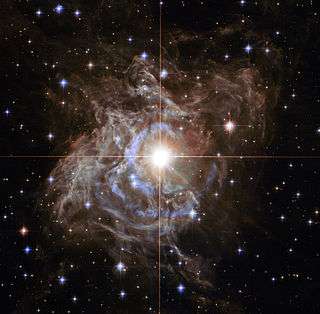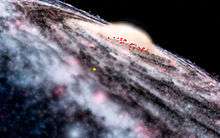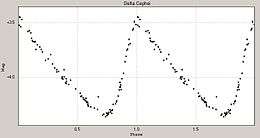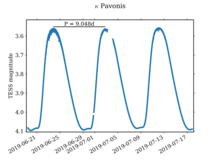Cepheid variable
A Cepheid variable (/ˈsɛfiːɪd, ˈsiːfiːɪd/) is a type of star that pulsates radially, varying in both diameter and temperature and producing changes in brightness with a well-defined stable period and amplitude.

A strong direct relationship between a Cepheid variable's luminosity and pulsation period[1][2] established Cepheids as important indicators of cosmic benchmarks for scaling galactic and extragalactic distances.[3][4][5][6] This robust characteristic of classical Cepheids was discovered in 1908 by Henrietta Swan Leavitt after studying thousands of variable stars in the Magellanic Clouds.[7] This discovery allows one to know the true luminosity of a Cepheid by simply observing its pulsation period. This in turn allows one to determine the distance to the star, by comparing its known luminosity to its observed brightness.
The term Cepheid originates from Delta Cephei in the constellation Cepheus, identified by John Goodricke in 1784, the first of its type to be so identified.
The mechanics of the pulsation as a heat-engine was proposed in 1917 by Arthur Stanley Eddington[8] (who wrote at length on the dynamics of Cepheids), but it was not until 1953 that S. A. Zhevakin identified ionized helium[9] as a likely valve for the engine.
Classes


Cepheid variables are divided into two subclasses which exhibit markedly different masses, ages, and evolutionary histories: classical Cepheids and type II Cepheids. Delta Scuti variables are A-type stars on or near the main sequence at the lower end of the instability strip and were originally referred to as dwarf Cepheids. RR Lyrae variables have short periods and lie on the instability strip where it crosses the horizontal branch. Delta Scuti variables and RR Lyrae variables are not generally treated with Cepheid variables although their pulsations originate with the same helium ionisation kappa mechanism.
Classical Cepheids

Classical Cepheids (also known as Population I Cepheids, type I Cepheids, or Delta Cepheid variables) undergo pulsations with very regular periods on the order of days to months. Classical Cepheids are Population I variable stars which are 4–20 times more massive than the Sun,[11] and up to 100,000 times more luminous.[12] These Cepheids are yellow bright giants and supergiants of spectral class F6 – K2 and their radii change by (~25% for the longer-period I Carinae) millions of kilometers during a pulsation cycle.[13]
Classical Cepheids are used to determine distances to galaxies within the Local Group and beyond, and are a means by which the Hubble constant can be established.[3][4][6][14][15] Classical Cepheids have also been used to clarify many characteristics of our galaxy, such as the Sun's height above the galactic plane and the Galaxy's local spiral structure.[5]
A group of classical Cepheids with small amplitudes and sinusoidal light curves are often separated out as Small Amplitude Cepheids or s-Cepheids, many of them pulsating in the first overtone.
Type II Cepheids

Type II Cepheids (also termed Population II Cepheids) are population II variable stars which pulsate with periods typically between 1 and 50 days.[16][17] Type II Cepheids are typically metal-poor, old (~10 Gyr), low mass objects (~half the mass of the Sun). Type II Cepheids are divided into several subgroups by period. Stars with periods between 1 and 4 days are of the BL Her subclass, 10–20 days belong to the W Virginis subclass, and stars with periods greater than 20 days belong to the RV Tauri subclass.[16][17]
Type II Cepheids are used to establish the distance to the Galactic Center, globular clusters, and galaxies.[5][18][19][20][21][22][23]
Anomalous Cepheids
A group of pulsating stars on the instability strip have periods of less than 2 days, similar to RR Lyrae variables but with higher luminosities. Anomalous Cepheid variables have masses higher than type II Cepheids, RR Lyrae variables, and our sun. It is unclear whether they are young stars on a "turned-back" horizontal branch, blue stragglers formed through mass transfer in binary systems, or a mix of both.[24][25]
Double-mode Cepheids
A small proportion of Cepheid variables have been observed to pulsate in two modes at the same time, usually the fundamental and first overtone, occasionally the second overtone.[26] A very small number pulsate in three modes, or an unusual combination of modes including higher overtones.[27]
History
On September 10, 1784, Edward Pigott detected the variability of Eta Aquilae, the first known representative of the class of classical Cepheid variables.[28] However, the eponymous star for classical Cepheids is Delta Cephei, discovered to be variable by John Goodricke a few months later.[29] The number of similar variables grew to several dozen by the end of the 19th century, and they were referred to as a class as Cepheids.[30] Most of the Cepheids were known from the distinctive light curve shapes with the rapid increase in brightness and a hump, but some with more symmetrical light curves were known as Geminids after the prototype ζ Geminorum.[31]
A relationship between the period and luminosity for classical Cepheids was discovered in 1908 by Henrietta Swan Leavitt in an investigation of thousands of variable stars in the Magellanic Clouds.[32] She published it in 1912 with further evidence.[33]
In 1913, Ejnar Hertzsprung attempted to find distances to 13 Cepheids using the motion through the sky.[34] His research would later require revision, however. In 1915, Harlow Shapley used Cepheids to place initial constraints on the size and shape of the Milky Way, and of the placement of our Sun within it. In 1924, Edwin Hubble established the distance to classical Cepheid variables in the Andromeda Galaxy, until then known as the Andromeda Nebula, and showed that the variables were not members of the Milky Way. Hubble's finding settled the question raised in the "Great Debate" of whether the Milky Way represented the entire Universe or was merely one of numerous galaxies in the Universe.[35]
In 1929, Hubble and Milton L. Humason formulated what is now known as Hubble's Law by combining Cepheid distances to several galaxies with Vesto Slipher's measurements of the speed at which those galaxies recede from us. They discovered that the Universe is expanding (see the expansion of the Universe). However, the expansion of the Universe was posited several years before by Georges Lemaître.[36]
In the mid 20th century, significant problems with the astronomical distance scale were resolved by dividing the Cepheids into different classes with very different properties. In the 1940s, Walter Baade recognized two separate populations of Cepheids (classical and type II). Classical Cepheids are younger and more massive population I stars, whereas type II Cepheids are older fainter Population II stars.[16] Classical Cepheids and type II Cepheids follow different period-luminosity relationships. The luminosity of type II Cepheids is, on average, less than classical Cepheids by about 1.5 magnitudes (but still brighter than RR Lyrae stars). Baade's seminal discovery led to a twofold increase in the distance to M31, and the extragalactic distance scale.[37][38] RR Lyrae stars, then known as Cluster Variables, were recognized fairly early as being a separate class of variable, due in part to their short periods.[39][40]
The mechanics of the pulsation as a heat-engine was proposed in 1917 by Arthur Stanley Eddington[41] (who wrote at length on the dynamics of Cepheids), but it was not until 1953 that S. A. Zhevakin identified ionized helium[42] as a likely valve for the engine.
Uncertainties in Cepheid determined distances
Chief among the uncertainties tied to the classical and type II Cepheid distance scale are: the nature of the period-luminosity relation in various passbands, the impact of metallicity on both the zero-point and slope of those relations, and the effects of photometric contamination (blending) and a changing (typically unknown) extinction law on Cepheid distances. All these topics are actively debated in the literature.[4][12][14][21][43][44][45][46][47][48][49][50]
These unresolved matters have resulted in cited values for the Hubble constant (established from Classical Cepheids) ranging between 60 km/s/Mpc and 80 km/s/Mpc.[3][4][6][14][15] Resolving this discrepancy is one of the foremost problems in astronomy since the cosmological parameters of the Universe may be constrained by supplying a precise value of the Hubble constant.[6][15] Uncertainties have diminished over the years, due in part to discoveries such as RS Puppis.
Delta Cephei is also of particular importance as a calibrator of the Cepheid period-luminosity relation since its distance is among the most precisely established for a Cepheid, partly because it is a member of a star cluster[51][52] and the availability of precise Hubble Space Telescope/Hipparcos parallaxes.[53] The accuracy of the distance measurements to Cepheid variables and other bodies within 7,500 lightyears is vastly improved by combining images from Hubble taken six months apart when the Earth and Hubble are on opposite sides of the Sun.[54]
Pulsation model
The accepted explanation for the pulsation of Cepheids is called the Eddington valve,[55] or "κ-mechanism", where the Greek letter κ (kappa) is the usual symbol for the gas opacity.
Helium is the gas thought to be most active in the process. Doubly ionized helium (helium whose atoms are missing both electrons) is more opaque than singly ionized helium. The more helium is heated, the more ionized it becomes. At the dimmest part of a Cepheid's cycle, the ionized gas in the outer layers of the star is opaque, and so is heated by the star's radiation, and due to the increased temperature, begins to expand. As it expands, it cools, and so becomes less ionized and therefore more transparent, allowing the radiation to escape. Then the expansion stops, and reverses due to the star's gravitational attraction. The process then repeats.
We follow the exposition in Salaris, Cassisi 2005. In 1879, Arthur Ritter demonstrated that the adiabatic radial pulsation period for a homogeneous sphere is related to its surface gravity and radius through the relation:
where k is a proportionality constant. Now, since the surface gravity is related to the sphere mass and radius through the relation:
one finally obtains:
where Q is called a constant, called the pulsation constant.
Examples
- Classical Cepheids include: Eta Aquilae, Zeta Geminorum, Beta Doradus, RT Aurigae, Polaris, as well as Delta Cephei.
- Type II Cepheids include: W Virginis and BL Herculis.[56]
- Anomalous Cepheids include: XZ Ceti[57] and BL Boötis.
References
- Udalski, A.; Soszynski, I.; Szymanski, M.; Kubiak, M.; Pietrzynski, G.; Wozniak, P.; Zebrun, K. (1999). "The Optical Gravitational Lensing Experiment. Cepheids in the Magellanic Clouds. IV. Catalog of Cepheids from the Large Magellanic Cloud". Acta Astronomica. 49: 223–317. arXiv:astro-ph/9908317. Bibcode:1999AcA....49..223U.
- Soszynski, I.; Poleski, R.; Udalski, A.; Szymanski, M. K.; Kubiak, M.; Pietrzynski, G.; Wyrzykowski, L.; Szewczyk, O.; Ulaczyk, K. (2008). "The Optical Gravitational Lensing Experiment. The OGLE-III Catalog of Variable Stars. I. Classical Cepheids in the Large Magellanic Cloud". Acta Astronomica. 58: 163. arXiv:0808.2210. Bibcode:2008AcA....58..163S.
- Freedman, Wendy L.; Madore, Barry F.; Gibson, Brad K.; Ferrarese, Laura; Kelson, Daniel D.; Sakai, Shoko; Mould, Jeremy R.; Kennicutt, Jr., Robert C.; Ford, Holland C.; Graham, John A.; Huchra, John P.; Hughes, Shaun M. G.; Illingworth, Garth D.; Macri, Lucas M.; Stetson, Peter B. (2001). "Final Results from the Hubble Space Telescope Key Project to Measure the Hubble Constant". The Astrophysical Journal. 553 (1): 47–72. arXiv:astro-ph/0012376. Bibcode:2001ApJ...553...47F. doi:10.1086/320638.
- Tammann, G. A.; Sandage, A.; Reindl, B. (2008). "The expansion field: the value of H 0". The Astronomy and Astrophysics Review. 15 (4): 289–331. arXiv:0806.3018. Bibcode:2008A&ARv..15..289T. doi:10.1007/s00159-008-0012-y.
- Majaess, D. J.; Turner, D. G.; Lane, D. J. (2009). "Characteristics of the Galaxy according to Cepheids". Monthly Notices of the Royal Astronomical Society. 398 (1): 263–270. arXiv:0903.4206. Bibcode:2009MNRAS.398..263M. doi:10.1111/j.1365-2966.2009.15096.x.
- Freedman, Wendy L.; Madore, Barry F. (2010). "The Hubble Constant". Annual Review of Astronomy and Astrophysics. 48: 673–710. arXiv:1004.1856. Bibcode:2010ARA&A..48..673F. doi:10.1146/annurev-astro-082708-101829.
- Leavitt, Henrietta S. (1908). "1777 variables in the Magellanic Clouds". Annals of Harvard College Observatory. 60: 87. Bibcode:1908AnHar..60...87L.
- Eddington, A. S. (1917). "The pulsation theory of Cepheid variables". The Observatory. 40: 290. Bibcode:1917Obs....40..290E.
- Zhevakin, S. A., "К Теории Цефеид. I", Астрономический журнал, 30 161–179 (1953)
- "VISTA Discovers New Component of Milky Way". Retrieved 29 October 2015.
- Turner, David G. (1996). "The Progenitors of Classical Cepheid Variables". Journal of the Royal Astronomical Society of Canada. 90: 82. Bibcode:1996JRASC..90...82T.
- Turner, David G. (2010). "The PL calibration for Milky Way Cepheids and its implications for the distance scale". Astrophysics and Space Science. 326 (2): 219–231. arXiv:0912.4864. Bibcode:2010Ap&SS.326..219T. doi:10.1007/s10509-009-0258-5.
- Rodgers, A. W. (1957). "Radius variation and population type of cepheid variables". Monthly Notices of the Royal Astronomical Society. 117: 85–94. Bibcode:1957MNRAS.117...85R. doi:10.1093/mnras/117.1.85.
- Ngeow, C.; Kanbur, S. M. (2006). "The Hubble Constant from Type Ia Supernovae Calibrated with the Linear and Nonlinear Cepheid Period-Luminosity Relations". The Astrophysical Journal. 642 (1): L29–L32. arXiv:astro-ph/0603643. Bibcode:2006ApJ...642L..29N. doi:10.1086/504478.
- Macri, Lucas M.; Riess, Adam G.; Guzik, Joyce Ann; Bradley, Paul A. (2009). "The SH0ES Project: Observations of Cepheids in NGC 4258 and Type Ia SN Hosts". AIP Conference Proceedings. STELLAR PULSATION: CHALLENGES FOR THEORY AND OBSERVATION: Proceedings of the International Conference. AIP Conference Proceedings. 1170. pp. 23–25. Bibcode:2009AIPC.1170...23M. doi:10.1063/1.3246452.
- Wallerstein, George (2002). "The Cepheids of Population II and Related Stars". Publications of the Astronomical Society of the Pacific. 114 (797): 689–699. Bibcode:2002PASP..114..689W. doi:10.1086/341698.
- Soszyński, I.; Udalski, A.; Szymański, M. K.; Kubiak, M.; Pietrzyński, G.; Wyrzykowski, Ł.; Szewczyk, O.; Ulaczyk, K.; Poleski, R. (2008). "The Optical Gravitational Lensing Experiment. The OGLE-III Catalog of Variable Stars. II.Type II Cepheids and Anomalous Cepheids in the Large Magellanic Cloud". Acta Astronomica. 58: 293. arXiv:0811.3636. Bibcode:2008AcA....58..293S.
- Kubiak, M.; Udalski, A. (2003). "The Optical Gravitational Lensing Experiment. Population II Cepheids in the Galactic Bulge". Acta Astronomica. 53: 117. arXiv:astro-ph/0306567. Bibcode:2003AcA....53..117K.
- Matsunaga, Noriyuki; Fukushi, Hinako; Nakada, Yoshikazu; Tanabé, Toshihiko; Feast, Michael W.; Menzies, John W.; Ita, Yoshifusa; Nishiyama, Shogo; et al. (2006). "The period-luminosity relation for type II Cepheids in globular clusters". Monthly Notices of the Royal Astronomical Society. 370 (4): 1979–1990. arXiv:astro-ph/0606609. Bibcode:2006MNRAS.370.1979M. doi:10.1111/j.1365-2966.2006.10620.x.
- Feast, Michael W.; Laney, Clifton D.; Kinman, Thomas D.; Van Leeuwen, Floor; Whitelock, Patricia A. (2008). "The luminosities and distance scales of type II Cepheid and RR Lyrae variables". Monthly Notices of the Royal Astronomical Society. 386 (4): 2115–2134. arXiv:0803.0466. Bibcode:2008MNRAS.386.2115F. doi:10.1111/j.1365-2966.2008.13181.x.
- Majaess, D.; Turner, D.; Lane, D. (2009). "Type II Cepheids as Extragalactic Distance Candles". Acta Astronomica. 59 (4): 403. arXiv:0909.0181. Bibcode:2009AcA....59..403M.
- Majaess, D. J. (2010). "RR Lyrae and Type II Cepheid Variables Adhere to a Common Distance Relation". The Journal of the American Association of Variable Star Observers. 38 (1): 100–112. arXiv:0912.2928. Bibcode:2010JAVSO..38..100M.
- Matsunaga, Noriyuki; Feast, Michael W.; Menzies, John W. (2009). "Period-luminosity relations for type II Cepheids and their application". Monthly Notices of the Royal Astronomical Society. 397 (2): 933–942. arXiv:0904.4701. Bibcode:2009MNRAS.397..933M. doi:10.1111/j.1365-2966.2009.14992.x.
- Caputo, F.; Castellani, V.; Degl'Innocenti, S.; Fiorentino, G.; Marconi, M. (2004). "Bright metal-poor variables: Why Anomalous Cepheids?". Astronomy and Astrophysics. 424 (3): 927–934. arXiv:astro-ph/0405395. Bibcode:2004A&A...424..927C. doi:10.1051/0004-6361:20040307.
- Soszyński, I.; Udalski, A.; Szymański, M. K.; Kubiak, M.; Pietrzyński, G.; Wyrzykowski, Ł.; Szewczyk, O.; Ulaczyk, K.; Poleski, R. (2008). "The Optical Gravitational Lensing Experiment. The OGLE-III Catalog of Variable Stars. II.Type II Cepheids and Anomalous Cepheids in the Large Magellanic Cloud". Acta Astronomica. 58: 293. arXiv:0811.3636. Bibcode:2008AcA....58..293S.
- Smolec, R.; Moskalik, P. (2008). "Double-Mode Classical Cepheid Models, Revisited". Acta Astronomica. 58: 233. arXiv:0809.1986. Bibcode:2008AcA....58..233S.
- Soszynski, I.; Poleski, R.; Udalski, A.; Kubiak, M.; Szymanski, M. K.; Pietrzynski, G.; Wyrzykowski, L.; Szewczyk, O.; Ulaczyk, K. (2008). "The Optical Gravitational Lensing Experiment. Triple-Mode and 1O/3O Double-Mode Cepheids in the Large Magellanic Cloud". Acta Astronomica. 58: 153. arXiv:0807.4182. Bibcode:2008AcA....58..153S.
- Pigott, Edward (1785). "Observations of a new variable star". Philosophical Transactions of the Royal Society. 75: 127–136. Bibcode:1785RSPT...75..127P. doi:10.1098/rstl.1785.0007.
- Goodricke, John (1786). "A series of observations on, and a discovery of, the period of the variation of the light of the star marked δ by Bayer, near the head of Cepheus. In a letter from John Goodricke, Esq. to Nevil Maskelyne, D.D.F.R.S. and Astronomer Royal". Philosophical Transactions of the Royal Society of London. 76: 48–61. Bibcode:1786RSPT...76...48G. doi:10.1098/rstl.1786.0002.
- Clarke, Agnes Mary (1903). Problems in Astrophysics. London, England: Adam & Charles Black. p. 319.
- Engle, Scott (2015). "The Secret Lives of Cepheids: A Multi-Wavelength Study of the Atmospheres and Real-Time Evolution of Classical Cepheids". arXiv:1504.02713. Bibcode:2015PhDT........45E. doi:10.5281/zenodo.45252. Cite journal requires
|journal=(help) - Leavitt, Henrietta S. (1908). "1777 variables in the Magellanic Clouds". Annals of the Astronomical Observatory of Harvard College. 60 (4): 87–108. Bibcode:1908AnHar..60...87L.
- Leavitt, Henrietta S.; Pickering, Edward C. (1912). "Periods of 25 variable stars in the Small Magellanic Cloud". Harvard College Observatory Circular. 173: 1–3. Bibcode:1912HarCi.173....1L.
- Hertzsprung, E. (1913). "Über die räumliche Verteilung der Veränderlichen vom δ Cephei-Typus" [On the spatial distribution of variable [stars] of the δ Cephei type]. Astronomische Nachrichten (in German). 196 (4692): 201–208. Bibcode:1913AN....196..201H.
- Hubble, E. P. (1925). "Cepheids in spiral nebulae". The Observatory. 48: 139. Bibcode:1925Obs....48..139H.
- Lemaître, G. (1927). "Un Univers homogène de masse constante et de rayon croissant rendant compte de la vitesse radiale des nébuleuses extra-galactiques". Annales de la Société Scientifique de Bruxelles. 47: 49. Bibcode:1927ASSB...47...49L.
- Baade, W. (1958). "Problems in the determination of the distance of galaxies". Astronomical Journal. 63: 207. Bibcode:1958AJ.....63..207B. doi:10.1086/107726.
- Allen, Nick. "Section 2: The Great Debate and the Great Mistake: Shapley, Hubble, Baade". The Cepheid Distance Scale: A History. Archived from the original on Dec 10, 2007.
- Shapley, Harlow. (1918). "No. 153. Studies based on the colors and magnitudes in stellar clusters. Eighth paper: The luminosities and distances of 139 Cepheid variables". Contributions from the Mount Wilson Observatory / Carnegie Institution of Washington. 153: 1. Bibcode:1918CMWCI.153....1S.
- Shapley, Harlow (1918). "Studies based on the colors and magnitudes in stellar clusters. Eighth paper: The luminosities and distances of 139 Cepheid variables". Astrophysical Journal. 48: 279–294. Bibcode:1918ApJ....48..279S. doi:10.1086/142435.
- Eddington, A. S. (1917). "The pulsation theory of Cepheid variables". The Observatory. 40: 290. Bibcode:1917Obs....40..290E.
- Zhevakin, S. A., "К Теории Цефеид. I", Астрономический журнал, 30 161–179 (1953)
- Benedict, G. Fritz; McArthur, Barbara E.; Feast, Michael W.; Barnes, Thomas G.; Harrison, Thomas E.; Patterson, Richard J.; Menzies, John W.; Bean, Jacob L.; Freedman, Wendy L. (2007). "Hubble Space Telescope Fine Guidance Sensor Parallaxes of Galactic Cepheid Variable Stars: Period-Luminosity Relations". The Astronomical Journal. 133 (4): 1810. arXiv:astro-ph/0612465. Bibcode:2007AJ....133.1810B. doi:10.1086/511980.
- Stanek, K. Z.; Udalski, A. (1999). "The Optical Gravitational Lensing Experiment. Investigating the Influence of Blending on the Cepheid Distance Scale with Cepheids in the Large Magellanic Cloud". arXiv:astro-ph/9909346.
- Udalski, A.; Wyrzykowski, L.; Pietrzynski, G.; Szewczyk, O.; Szymanski, M.; Kubiak, M.; Soszynski, I.; Zebrun, K. (2001). "The Optical Gravitational Lensing Experiment. Cepheids in the Galaxy IC1613: No Dependence of the Period-Luminosity Relation on Metallicity". Acta Astronomica. 51: 221. arXiv:astro-ph/0109446. Bibcode:2001AcA....51..221U.
- Macri, L. M.; Stanek, K. Z.; Bersier, D.; Greenhill, L. J.; Reid, M. J. (2006). "A New Cepheid Distance to the Maser‐Host Galaxy NGC 4258 and Its Implications for the Hubble Constant". The Astrophysical Journal. 652 (2): 1133–1149. arXiv:astro-ph/0608211. Bibcode:2006ApJ...652.1133M. doi:10.1086/508530.
- Bono, G.; Caputo, F.; Fiorentino, G.; Marconi, M.; Musella, I. (2008). "Cepheids in External Galaxies. I. The Maser‐Host Galaxy NGC 4258 and the Metallicity Dependence of Period‐Luminosity and Period‐Wesenheit Relations". The Astrophysical Journal. 684 (1): 102–117. arXiv:0805.1592. Bibcode:2008ApJ...684..102B. doi:10.1086/589965.
- Madore, Barry F.; Freedman, Wendy L. (2009). "Concerning the Slope of the Cepheid Period-Luminosity Relation". The Astrophysical Journal. 696 (2): 1498–1501. arXiv:0902.3747. Bibcode:2009ApJ...696.1498M. doi:10.1088/0004-637X/696/2/1498.
- Scowcroft, V.; Bersier, D.; Mould, J. R.; Wood, P. R. (2009). "The effect of metallicity on Cepheid magnitudes and the distance to M33". Monthly Notices of the Royal Astronomical Society. 396 (3): 1287–1296. arXiv:0903.4088. Bibcode:2009MNRAS.396.1287S. doi:10.1111/j.1365-2966.2009.14822.x.
- Majaess, D. (2010). "The Cepheids of Centaurus A (NGC 5128) and Implications for H0". Acta Astronomica. 60 (2): 121. arXiv:1006.2458. Bibcode:2010AcA....60..121M.
- De Zeeuw, P. T.; Hoogerwerf, R.; De Bruijne, J. H. J.; Brown, A. G. A.; Blaauw, A. (1999). "A HIPPARCOS Census of the Nearby OB Associations". The Astronomical Journal. 117 (1): 354–399. arXiv:astro-ph/9809227. Bibcode:1999AJ....117..354D. doi:10.1086/300682.
- Majaess, D.; Turner, D.; Gieren, W. (2012). "New Evidence Supporting Cluster Membership for the Keystone Calibrator Delta Cephei". The Astrophysical Journal. 747 (2): 145. arXiv:1201.0993. Bibcode:2012ApJ...747..145M. doi:10.1088/0004-637X/747/2/145.
- Benedict, G. Fritz; McArthur, B. E.; Fredrick, L. W.; Harrison, T. E.; Slesnick, C. L.; Rhee, J.; Patterson, R. J.; Skrutskie, M. F.; Franz, O. G.; Wasserman, L. H.; Jefferys, W. H.; Nelan, E.; Van Altena, W.; Shelus, P. J.; Hemenway, P. D.; Duncombe, R. L.; Story, D.; Whipple, A. L.; Bradley, A. J. (2002). "Astrometry with the Hubble Space Telescope: A Parallax of the Fundamental Distance Calibrator δ Cephei". The Astronomical Journal. 124 (3): 1695. arXiv:astro-ph/0206214. Bibcode:2002AJ....124.1695B. doi:10.1086/342014.
- Riess, Adam G.; Casertano, Stefano; Anderson, Jay; MacKenty, John; Filippenko, Alexei V. (2014). "Parallax beyond a Kiloparsec from Spatially Scanning the Wide Field Camera 3 on the Hubble Space Telescope". The Astrophysical Journal. 785 (2): 161. arXiv:1401.0484. Bibcode:2014ApJ...785..161R. doi:10.1088/0004-637X/785/2/161.
- Smith, D. H. (1984). "Eddington's Valve and Cepheid Pulsations". Sky and Telescope. 68: 519. Bibcode:1984S&T....68..519S.
- Gorynya, N. A.; Samus, N. N.; Rastorguev, A. S.; Sachkov, M. E. (1996). "A spectroscopic study of the pulsating star BL Her". Astronomy Letters. 22 (3): 326. Bibcode:1996AstL...22..326G.
- Szabados, L.; Kiss, L. L.; Derekas, A. (2007). "The anomalous Cepheid XZ Ceti". Astronomy and Astrophysics. 461 (2): 613–618. arXiv:astro-ph/0609097. Bibcode:2007A&A...461..613S. doi:10.1051/0004-6361:20065690.
External links
- McMaster Cepheid Photometry and Radial Velocity Data Archive
- American Association of Variable Star Observers
- Stellar pulsation theory - Regular versus irregular variability
- Survey of Warsaw University at Las Campanas Observatory: OGLE-III (Optical Gravitational Lensing Experiment) Variable Stars catalog website
- David Dunlap Observatory of Toronto University: Galactic Classical Cepheids database